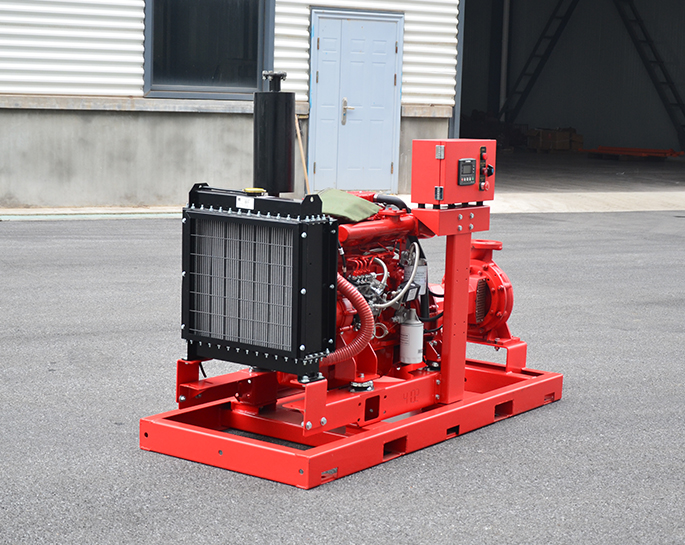How do you address corrosion in fire pump systems?
Jun 07, 2024
Share:
Fire pump systems are critical components of fire protection systems in buildings and industrial facilities. These systems are designed to provide a reliable source of water at high pressure to extinguish fires when the building's main water supply is insufficient or unavailable. Here's an overview of fire pump systems:
1. **Purpose**: Fire pump systems are installed to ensure adequate water pressure and flow rate for firefighting operations. They are typically used in buildings where the existing water supply is inadequate to meet the demands of sprinkler systems or standpipes.
2. **Components**:
- **Pump**: The heart of the fire pump system, responsible for pressurizing water from the water source (such as a dedicated fire water tank, municipal water supply, or reservoir) and delivering it to the fire protection system.
- **Driver**: Usually an electric motor or diesel engine, which provides the power to drive the pump.
- **Controller**: Monitors the system and starts the pump automatically when water pressure drops below a certain level.
- **Water Source**: Could be a dedicated fire water tank, municipal water supply, reservoir, or other approved sources.
- **Piping**: Distributes water from the pump to various points in the building, such as sprinkler heads or standpipes.
3. **Types**:
- **Horizontal Split Case**: The most common type, with the pump split horizontally to allow for easy maintenance.
- **Vertical Inline**: Compact design where the pump and motor are mounted on a common shaft.
- **Vertical Turbine**: Suitable for high-rise buildings, where the pump is submerged in the water source.
4. **Operation**:
- Fire pumps are typically activated automatically when a drop in water pressure is detected in the fire protection system, indicating a fire.
- They can also be manually activated if necessary.
- Regular testing and maintenance are essential to ensure the system operates effectively when needed.
5. **Codes and Standards**: Fire pump systems must comply with local building codes, as well as standards set by organizations such as the National Fire Protection Association (NFPA), particularly NFPA 20, which provides guidelines for the installation, operation, and maintenance of fire pump systems.
6. **Maintenance**: Regular maintenance and testing are crucial to ensure the reliability of fire pump systems. This includes weekly, monthly, quarterly, and annual inspections and testing as outlined by NFPA standards.
Overall, fire pump systems are vital for ensuring the safety of occupants and protecting property in the event of a fire. Proper design, installation, and maintenance are essential to their effectiveness.

1. **Purpose**: Fire pump systems are installed to ensure adequate water pressure and flow rate for firefighting operations. They are typically used in buildings where the existing water supply is inadequate to meet the demands of sprinkler systems or standpipes.
2. **Components**:
- **Pump**: The heart of the fire pump system, responsible for pressurizing water from the water source (such as a dedicated fire water tank, municipal water supply, or reservoir) and delivering it to the fire protection system.
- **Driver**: Usually an electric motor or diesel engine, which provides the power to drive the pump.
- **Controller**: Monitors the system and starts the pump automatically when water pressure drops below a certain level.
- **Water Source**: Could be a dedicated fire water tank, municipal water supply, reservoir, or other approved sources.
- **Piping**: Distributes water from the pump to various points in the building, such as sprinkler heads or standpipes.
3. **Types**:
- **Horizontal Split Case**: The most common type, with the pump split horizontally to allow for easy maintenance.
- **Vertical Inline**: Compact design where the pump and motor are mounted on a common shaft.
- **Vertical Turbine**: Suitable for high-rise buildings, where the pump is submerged in the water source.
4. **Operation**:
- Fire pumps are typically activated automatically when a drop in water pressure is detected in the fire protection system, indicating a fire.
- They can also be manually activated if necessary.
- Regular testing and maintenance are essential to ensure the system operates effectively when needed.
5. **Codes and Standards**: Fire pump systems must comply with local building codes, as well as standards set by organizations such as the National Fire Protection Association (NFPA), particularly NFPA 20, which provides guidelines for the installation, operation, and maintenance of fire pump systems.
6. **Maintenance**: Regular maintenance and testing are crucial to ensure the reliability of fire pump systems. This includes weekly, monthly, quarterly, and annual inspections and testing as outlined by NFPA standards.
Overall, fire pump systems are vital for ensuring the safety of occupants and protecting property in the event of a fire. Proper design, installation, and maintenance are essential to their effectiveness.


.png)
.png)

.png)


